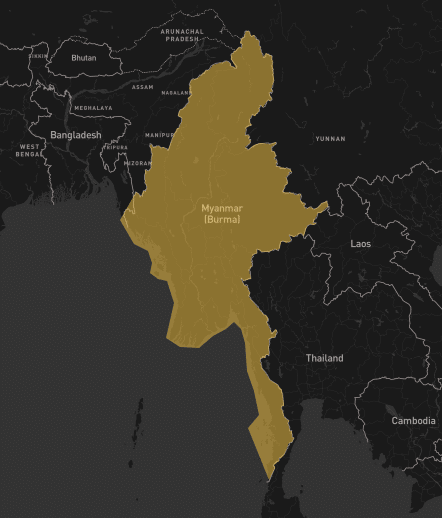Background
The February 2021 coup by Myanmar's armed forces (the Tatmadaw) has significantly increased the risk to aviation operations over the country. As a result of the ongoing conflict between rebel groups and the military government, the Myanmar Air Force (MAF) has conducted numerous airstrikes in support of military operations on the ground. In turn, violent non-state actor (VNSA) ethnic rebel groups have targeted both airports and air assets with a range of weaponry and, while unconfirmed, there have also been reports of aircraft shot down. Since the beginning of 2023, rebel groups have been increasingly using weaponised drones to carry out attacks on Tatmadaw forces. Most recently, on 26 February, one of these groups, the Chin National Army (CNA), allegedly damaged a military helicopter by dropping an explosive device on the aircraft as it landed during operations in Chin state, forcing the aircraft to make an emergency landing in Hakha. Osprey Flight Solutions actively monitors airspace risk associated with the situation in Myanmar and issues analysis and advice to clients via alerts.
Data Analysis
In Myanmar, the primary threat to aviation is misidentification by VNSA ethnic rebel groups targeting MAF aircraft. Such groups have access to man-portable air-defence systems (MANPADS), the most capable variants of which, according to the US FAA, can be effective up to 25,000 feet AGL. These groups also possess weaponry capable of engaging aircraft up to FL100, including unguided anti-tank weapons, rocket-propelled grenades and low-calibre anti-aircraft artillery. Since the start of 2021, such groups have claimed to have conducted attacks against MAF air assets, with one such incident in February 2022 involving the downing of a MAF combat aircraft and another in May 2021 involving the downing of a military helicopter. Both these claimed shoot-down incidents appear to have occurred via the use of MANPADS.

Aerial operations by the Tatmadaw against VNSA rebel groups - such as the one that occurred on the Indian/Myanmar border 10 January 2023 - increase the likelihood of attempted surface-to-air fire engagements by the ethnic rebel groups targeting military-grade air assets below FL260, as well as armed attacks against fortified installations with aviation infrastructure, as a means of retaliation against the government. Notably, in September 2022, a Myanmar National Airlines aircraft was reported to have been shot at by small-arms fire as it was on approach to Loikaw Airport (VYLK/LIW) in Kayah state, eastern Myanmar.
Outlook
Given the nature of the conflict in Myanmar, it is unlikely that the situation will improve unless the Tatmadaw makes noticeable gains against insurgent groups. As such, armed clashes between these ethnic rebel groups and the Tatmadaw throughout the country are expected to continue until a ceasefire is reached between the combatant factions. Asymmetric targeting of armed forces' aviation installations, airbases and airports along with aircraft at low altitudes in areas of heightened ethnic rebel group activity in the country therefore remains a credible threat. As such, air assets at low altitudes or on the ground in areas of heightened ethnic rebel group activity will remain vulnerable. Notably, there are currently no conflict zone notices, restrictions, prohibitions, advisories, bulletins, circulars or publications issued by most leading civil aviation governing bodies (US FAA, UK DfT, French DGAC, Transport Canada and EASA) covering Myanmar. Only the German LBA has issued advice to its operators, advising them of the potential risk in FIR Yangon (VYYF) below FL160 from military operations, surface-to-air fire and anti-aviation weaponry (NOTAM EDGG/EDWW/EDMM B0141/23). Osprey will continue to monitor airspace risk in the region and update its clients on the latest aviation operating situation.








